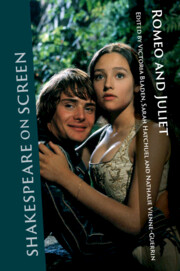Book contents
- Shakespeare on Screen: Romeo and Juliet
- Series page
- Shakespeare on Screen: Romeo and Juliet
- Copyright page
- Dedication
- Contents
- Figures
- Notes on Contributors
- Series Editors’ Preface
- Acknowledgements
- Chapter 1 Introduction – From Canon to Queer: Romeo and Juliet on Screen
- Part I Revisiting the Canon
- Part II Extending Genre
- Part III Serial and Queer Romeo and Juliets
- Index
- References
Part II - Extending Genre
Published online by Cambridge University Press: 10 October 2023
- Shakespeare on Screen: Romeo and Juliet
- Series page
- Shakespeare on Screen: Romeo and Juliet
- Copyright page
- Dedication
- Contents
- Figures
- Notes on Contributors
- Series Editors’ Preface
- Acknowledgements
- Chapter 1 Introduction – From Canon to Queer: Romeo and Juliet on Screen
- Part I Revisiting the Canon
- Part II Extending Genre
- Part III Serial and Queer Romeo and Juliets
- Index
- References
Summary

- Type
- Chapter
- Information
- Shakespeare on Screen: Romeo and Juliet , pp. 93 - 168Publisher: Cambridge University PressPrint publication year: 2023

